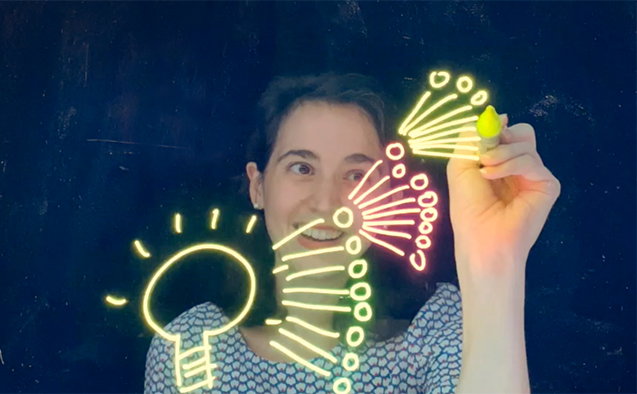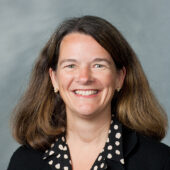The power of professors: Peer learning communities advance the art of teaching during a pandemic

For four weeks this summer, biostatistics professor Lucy D’Agostino McGowan gathered virtually with a group of other Wake Forest University professors to read the latest research on teaching online, learn how to use digital tools to increase student engagement and debate best practices for inclusive instruction. She annotated articles using Hypothesis, recorded videos on Voice Thread and experimented with Zoom breakout rooms. Using plexiglass and ingenuity, she built a lightboard for her home office so students joining her class online could more easily follow the steps in solving an equation.
McGowan is one of 68 peer facilitators in Wake Forest’s new Peer-to-Peer Learning Communities program who have collectively created small learning communities for an additional 650 faculty – both the tech-savvy and the tech-skeptical. Most of these communities of 10-15 people are discipline specific, but a few are interdisciplinary.
As universities nationwide struggle to translate face-to-face classroom learning to online teaching and potentially blend the two, Wake Forest has launched a comprehensive program to support faculty that goes beyond teaching technological skills. More than 90% of Wake Forest faculty are participating.
After the University’s rapid move to remote learning in March, Executive Director of the Center for the Advancement of Teaching Betsy Barre realized it was not enough to offer faculty webinars about online and blended teaching practices and provide access to new software. They needed a forum for exchanging ideas and connecting with colleagues.
“We are investing in the art of teaching as much as technology.” Betsy Barre, Executive Director of the Center for the Advancement of Teaching
“I knew that our teachers and the communities they’ve created over the past few months had to be at the heart of whatever we did,” Barre said. “This project speaks to how much Wake cares about teaching. The project creates opportunities for departments to have meaningful conversations about teaching that will reach far beyond a single semester.”

Betsy Barre
The intensive, collaborative four-week boot camp incorporated whole-group class meetings and independent assignments, group work and individual projects – the same learning landscape their students will navigate this fall as professors teach in-person, blended and online courses. They created podcasts, researched online datasets and resources, recorded an “introduce myself to the class” video – completing the kind of assignments they might, in turn, ask their students to complete. The faculty-centered approach is supported by a team of eight staff from four support offices -The Center for the Advancement of Teaching, the Office of Online Education, the Z. Smith Reynolds Library Digital Initiatives team and the Academic Technologies unit in Information Systems.
Each facilitator surveyed their peers in their own departments to find out what they needed and wanted to learn, put together a course map tailored to those needs, and launched their own learning communities. They are using a variety of tools, including Canvas, a Google group and Slack, to stay connected and share questions and experiences throughout the semester.
Necessity creates opportunity
Communication professor Marina Krcmar signed up to be a facilitator because she wanted to help colleagues who may not already be skillfully using dozens of the latest technologies.
“With proper training, faculty can really develop and deliver a great course experience that encourages a sense of community, encourages a sense of connection to the class, of connection to other human beings. Critical thinking skills, analytical skills, great communication skills — all of that can be done in an online environment, but it doesn’t get done magically. You have to learn how to do it,” Krcmar said.
Sociology professor David Yamane, who got his first experience teaching online this year, said the learning communities approach is different from what many of his colleagues are experiencing at other institutions.
“We don’t have to face it alone. We can face it as a community.” David Yamane, Professor of Sociology
“The University came up with this very systematic way of getting us all prepared to teach in different modalities in the fall and that played right into the spirit that was already happening among the faculty and gave it the resources and the direction that we needed,” Yamane said.
The undergraduate, graduate and professional school faculty are all participating in this initiative. Peer facilitators have built a network of colleagues doing the same work from schools and departments across the University including law, business, politics, divinity, the humanities, the sciences and the arts.
“The collective wisdom of people throughout the University is a real benefit to students in the fall,” Yamane said.
Math professor Jason Parsley has enjoyed the collaboration.
“My role is guiding instructors to develop activities that work well in an online or blended environment. My colleagues have such excellent ideas: different technology tools, various ways to engage virtually with students, ways to structure exams and other assessments. We work backwards from our overall course goals and learning outcomes to build a course that accomplishes these; from looking at the exams to the assignments to the day-to-day learning that must occur for it to happen.”
The Peer-to-Peer Learning Communities have broad University support from the president, provost and deans.
“This program is designed to uphold Wake Forest’s powerful commitment to teaching regardless of modality. It ensures faculty can facilitate community, inclusivity and engagement in digital spaces; and that all our faculty will know how to deliver learning excellence.” Michele Gillespie, Dean of the College
Carrying it forward
Krcmar can’t wait to get back to the in-person classroom teaching she loves, but she said she is excited about what she is learning as a peer facilitator and what she can do to help colleagues.
“This is absolutely the right way to do it,” she said. “By training all of us to be better online teachers, it has by extension made me a better instructor. Our entire faculty body will benefit from this because it has a long-term impact that simply putting cameras in classrooms just doesn’t.”
Parsley agreed: “Several of my department colleagues have remarked to me: ‘Hey, this assignment/video/example/structure that I’m building right now will work really well when we’re back face-to-face.’ That’s so rewarding; by having the entire Wake Forest faculty focus on improving their online teaching, future classes of Wake students all benefit.”
Reimagining courses
Using imagination and technology, faculty have redesigned courses to provide exceptional teaching in-person and online.
- A biology professor is using a database of images of African wildlife called Snapshot Serengeti to bridge in-person and online teaching.
- A math professor developed guided notes – essentially a digital Calculus “textbook” – with more than 200 videos.
- English professors collaborated to rethink writing assignments, including a project to create a digital, interactive history for “The Handmaid’s Tale” by Margaret Atwood.
Categories: Experiential Learning, Research & Discovery
Wake Forest News
336.758.5237
media@wfu.edu
Meet the News Team
Headlines
Wake Forest in the News
Wake Forest regularly appears in media outlets around the world.




